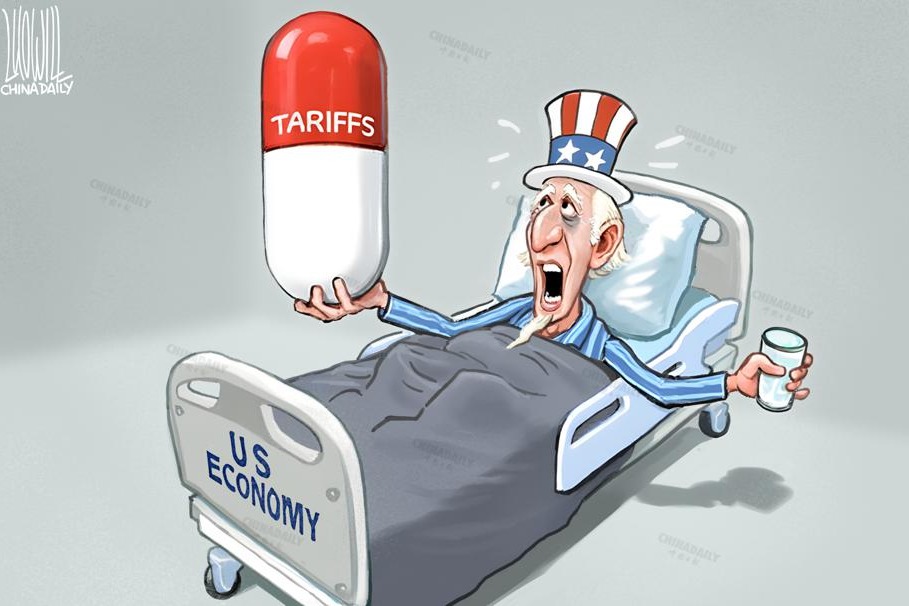Increased consumption can offset tariff disruption


The upcoming May Day holiday is poised to showcase China's economic resilience, much like during the Spring Festival and other holidays. This is crucial for China to bolster consumption in the face of global tariff shocks.
While China cannot avoid the impact of the United States' punitive tariffs, its economy remains on the recovery track. The same cannot be said of the US economy with concerns growing about its health.
Recently, these concerns have been escalating as a result of the US trade war.
In the fourth quarter of 2024, China's economic growth accelerated from 4.6 percent to 5.4 percent, with annualized growth of 5.0 percent last year. Before the US tariff war, China's economy showed increasing signs of stabilization. Hence, the International Monetary Fund's upgrade to its China's GDP growth forecast.
Despite substantial external headwinds, the Chinese government has set a 5 percent GDP growth target for 2025, signaling confidence in the economy's resilience to offset the tariff war. Concurrently, the fiscal deficit-to-GDP ratio has been raised to 4 percent as policymakers set a 2 percent consumer price index inflation target.
Here's the bottom line: The expansion of domestic demand is no longer just a cyclical effort. It is not simply a tool to respond to business cycles. It reflects the structural transformation of the Chinese economy away from exports and investment toward greater consumption and innovation.
Last year, consumer spending contributed nearly 45 percent of China's economic growth, surpassing investment and exports. The objective is to raise spending power by increasing earnings and reducing financial burdens. Hence, the aim to create 12 million new jobs and keep unemployment at 5.5 percent. Such goals are vital to the recovery of consumption that is premised on solid wage development and a steadying property market. These initiatives have been coupled with special initiatives to boost consumption.
These efforts are on track. In the first quarter of the year, China's economy grew by 5.4 percent. Remarkably, the signs of progress were broad. Industrial production growth climbed to 6.5 percent year-to-year, fueled by both external and domestic demand. Export growth accelerated to 5.8 percent, almost 2.5 times, although largely due to exporters front-loading shipments prior to the tariff penalties.
State-sector spending continued to drive fixed asset investment growth, particularly in automobiles and equipment. In property markets, contraction continued to narrow, with developers pushing for the completion of unfinished homes. The improvement of liquidity conditions suggests Chinese households are more willing to spend, while companies are increasingly investing.
China's broad push of "effective demand" is not just classic Keynesianism, however. There is another side to the story.
Technological innovation and emerging industries are critical to sustain the rising demand. This is why China is increasingly pushing for rapid progress in "new quality productive forces", especially artificial intelligence.
For some time, the Chinese government has fostered "industries of the future", including embodied AI, 6G, quantum technology and biomanufacturing. The dramatic rise of DeepSeek without US-style billions of dollars in subsidies reflects the rapidly-changing new realities. In 2024, TikTok, CapCut and Temu were already among the top-10 most popular apps worldwide.
In the past few quarters, the gains of the Chinese economy suggest that a virtuous circle of disruptive innovation and effective demand, with the government as the catalytic force, could be in the making. And that's precisely what the US' tariffs hope to undermine. The US administration's record-high 245 percent tariffs on some Chinese imports seek to disrupt, undermine and reverse the recovery of China's economy.
The "reciprocal tariffs", which have been announced by the US administration, are unilateral, flawed and mistakenly calculated.
According to new data by the IMF, the US tariffs could downgrade US growth by a one-third to 1.8 percent, with a 40 percent probability of a recession. Europe's largest economies and Japan will suffer even more, with growth almost halved. Global growth could plunge to 2.8 percent, which would penalize particularly the most vulnerable economies in the Global South.
And yet, the US administration is flirting with even more tariffs, planning to use tariff negotiations to pressure US partners to limit their dealings with China.
Such a scenario could prove lethal to the ailing world economy.
The author is the founder of Difference Group and has served at the India, China and America Institute (US), Shanghai Institutes for International Studies (China) and the EU Center (Singapore). The views don't necessarily represent those of China Daily.
If you have a specific expertise, or would like to share your thought about our stories, then send us your writings at opinion@chinadaily.com.cn, and comment@chinadaily.com.cn.

































